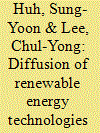|
|
|
Sort Order |
|
|
|
Items / Page
|
|
|
|
|
|
|
| Srl | Item |
| 1 |
ID:
149834


|
|
|
|
|
| Summary/Abstract |
The aim of this paper is twofold. First, we assess the SIDS' pattern towards energy sustainability. Second, we try to understand the macro factors that drive policy–makers in setting the optimal framework for investments in renewable energy sources. The empirical analysis is performed on a large dataset of 136 countries and 41 variables observed in the time span 2000–2011. Countries analyzed include a sample of 12 SIDS (Bahrain, Cuba, Dominican Republic, Fiji Islands, Guyana, Haiti, Jamaica, Maldives, Mauritius, Papua New Guinea, Singapore, Trinidad and Tobago) distributed worldwide. Due to the large number of variables collected and their high degree of collinearity, the first step of the analysis concerns the implementation of a Principal Component Analysis in order to extract factors explaining the majority of variation of the original variables. In the second step, three different scenarios of modeling are designed to examine the key factors promoting RES investments. In a first scenario, we employ a pooled regression model, in the second a Fixed Effect model and, in the third, a Random Effect model is estimated. The main results of empirical analysis could be unexpected at first sight. They show, in fact, that SIDS are not on a energy sustainability path. As in the case of other developing countries, policy–makers prefer to use resources to improve economic aspects of development leaving behind issues related to the environmental protection, the use of RES and sustainability. In order to improve economic and environmental resilience of SIDS a synergy between local governments and international organizations to promote the investments in RES is needed. Moreover, an energy plan that clearly supports the generation of energy from RES is recommended. Finally policy–makers should strength their commitment in raising population's awareness toward a green energy generation. Such synergic interventions will allow SIDS to achieve a more sustainable development.
|
|
|
|
|
|
|
|
|
|
|
|
|
|
|
|
| 2 |
ID:
132658


|
|
|
|
|
| Publication |
2014.
|
| Summary/Abstract |
Renewable energy technologies (RETs) have attracted significant public attention for several reasons, the most important being that they are clean alternative energy sources that help reduce greenhouse gas emissions. To increase the probability that RETs will be successful, it is essential to reduce the uncertainty about its adoption with accurate long-term demand forecasting. This study develops a diffusion model that incorporates the effect of competitive interrelationships among renewable sources to forecast the growth pattern of five RETs: solar photovoltaic, wind power, and fuel cell in the electric power sector, and solar thermal and geothermal energy in the heating sector. The 2-step forecasting procedure is based on the Bayus, (1993. Manage. Sci. 39, 11, 1319-1333) price function and a diffusion model suggested by Hahn et al. (1994. Marketing Sci. 13, 3, 224-247). In an empirical analysis, the model is applied to the South Korean renewable energy market.
|
|
|
|
|
|
|
|
|
|
|
|
|
|
|
|
| 3 |
ID:
121031


|
|
|
|
|
| Publication |
2013.
|
| Summary/Abstract |
Despite efforts by some congressional legislators to pass laws to limit greenhouse gas emissions and reduce the use of fossil fuels, no such laws have yet been adopted. Is this failure to pass new laws attributable to a lack of public desire for such legislation? Data from national surveys support two answers to this question. First, large majorities of Americans have endorsed a variety of policies designed to reduce greenhouse gas emissions; second, policy support has been consistent across years and across scopes and types of policies. Popular policies include fuel economy and energy-efficiency standards, mandated use of renewable sources, and limitations on emissions by utilities and by businesses more generally. Support for policies has been price sensitive, and the American public appears to have been willing to pay enough money for these purposes to cover their costs. Consistent with these policy endorsements, surveys show that large majorities of Americans believe that global warming has been happening, that it is attributable to human activity, and that future warming will be a threat if unaddressed. Not surprisingly, these beliefs appear to have been important drivers of public support for policies designed to reform energy generation and use. Thus, it seems inappropriate to attribute lack of legislation to lack of public support in these arenas.
|
|
|
|
|
|
|
|
|
|
|
|
|
|
|
|
| 4 |
ID:
128444


|
|
|
|
|
| Publication |
2013.
|
| Summary/Abstract |
Energy security is considered to be a universal issue in the twenty-first century. It denotes the right to use reliable sources of energy at competitive prices produced in an environmentally sustainable and safe means as well as the security of supply and demand. The strategic significance of energy security has been stirred by the political and economic events since 1970. The purpose of energy security is to guarantee adequate, reliable supplies of energy at reasonable prices in ways that do not endanger major national values and objectives. Energy security has different dimensions that vary from economic, environmental, social, foreign and technological progress which differ from country to country, and also from one period to another. To meet the growing aspirations of the people and the economies of South Asia, countries are under massive social and political strain to secure reliable, sustainable and reasonably priced energy supplies to meet the escalating demand for commercial energy. Energy security is thus no longer merely a catchword but an irrefutable reality for vital economic development throughout South Asia. And energy security will remain a high priority issue all over the world and the duty of ensuring energy security to the people and the state is not only confined to national governments but also to regional and international regime. This article analyses the emerging trends of energy security through the most debated contemporary issues such as climate change, sustainable development and globalisation.
|
|
|
|
|
|
|
|
|
|
|
|
|
|
|
|
| 5 |
ID:
180101


|
|
|
|
|
| Summary/Abstract |
Being declared a global emergency, the COVID-19 pandemic has taken many lives, threatened livelihoods and businesses around the world. The energy industry, in particular, has experienced tremendous pressure resulting from the pandemic. In response to such a challenge, the development of sustainable resources and renewable energy infrastructure has demonstrated its potential as a promising and effective strategy. To sufficiently address the effect of COVID-19 on renewable energy development strategies, short-term policy priorities should be identified, while mid-term and long-term action plans should be formulated in achieving the well-defined renewable energy targets and progress towards a more sustainable energy future. In this review, opportunities, challenges, and significant impacts of the COVID-19 pandemic on current and future sustainable energy strategies were analyzed in detail; while drawing from experiences in identifying reasonable behaviors, orientating appropriate actions, and policy implications on the sustainable energy trajectory were also mentioned. Indeed, the question is that whether the COVID-19 pandemic will kill us or provide us with a precious lesson on future sustainable energy development.
|
|
|
|
|
|
|
|
|
|
|
|
|
|
|
|
| 6 |
ID:
132655


|
|
|
|
|
| Publication |
2014.
|
| Summary/Abstract |
Renewable energy promotion and its cost are at the heart of the energy policy debate in many countries. The question from an economic perspective is how expensive the promotion of renewable sources through price-based incentive schemes is. This paper addresses this issue empirically. We analyze the Spanish electricity market during the period 2008-2012, where renewable energy production rose by 57%. To determine how expensive it was, we first measure the savings due to the spot price reduction driven by the merit order effect and, second, we compute the amount paid as incentives to green energy by the electricity system; the difference between the two is the net cost of green energy to the electricity markets. We present aggregate results for renewable sources as a whole, as well as individual results for each technology. We show that at the initial stages, when renewable capacity was low, green energy promotion paid for itself (2008-2009); however, from 2010 on, when renewable production reached a relatively high level, it started to impose a positive net cost on the system. Finally, we found substantial differences among technologies: wind energy implied the lowest net cost, while solar photovoltaic was the most expensive.
|
|
|
|
|
|
|
|
|
|
|
|
|
|
|
|
|
|
|
|
|